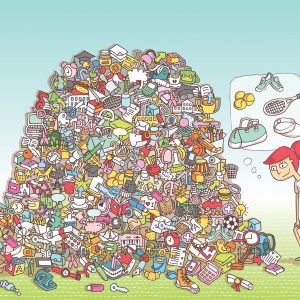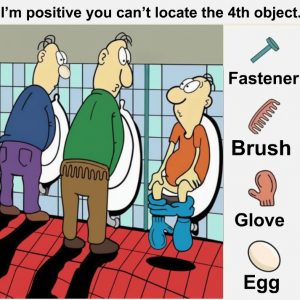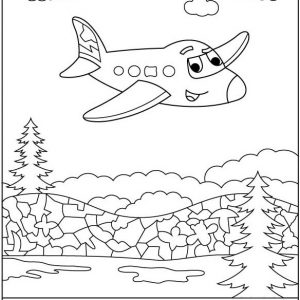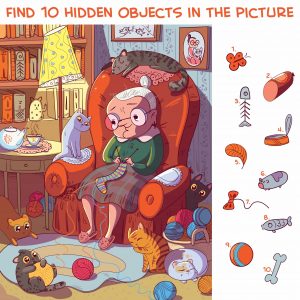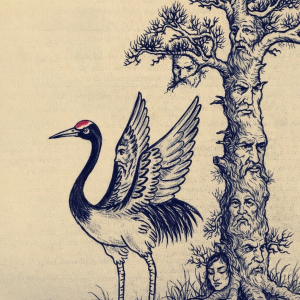Unlocking the Mystery: How Many Hidden Faces Can You Spot in This Optical Illusion?
Why Hidden-Face Illusions Captivate Our Curiosity
Have you ever glanced at a swirling pattern or a cleverly drawn hairstyle and suddenly noticed a face staring back? That surprising “Aha!” moment is what makes hidden-face illusions so addictive. These artworks play with our perception, tapping into a phenomenon called pareidolia—our brain’s tendency to see familiar patterns, especially faces, in random shapes. When you encounter an image like the one above—a flowing hair-like design concealing multiple profiles—you lean in, eager to uncover each secret. This blend of mystery, discovery, and playful challenge engages us instantly. Plus, sharing “I found seven faces!” with friends invites friendly competition and social bonding. In this article, we’ll dive into why these illusions fascinate us, how to decode a multi-face drawing, strategies for spotting every hidden visage, and even how to craft your own illusions. Ready to train your eyes and sharpen your mind? Let’s get started.
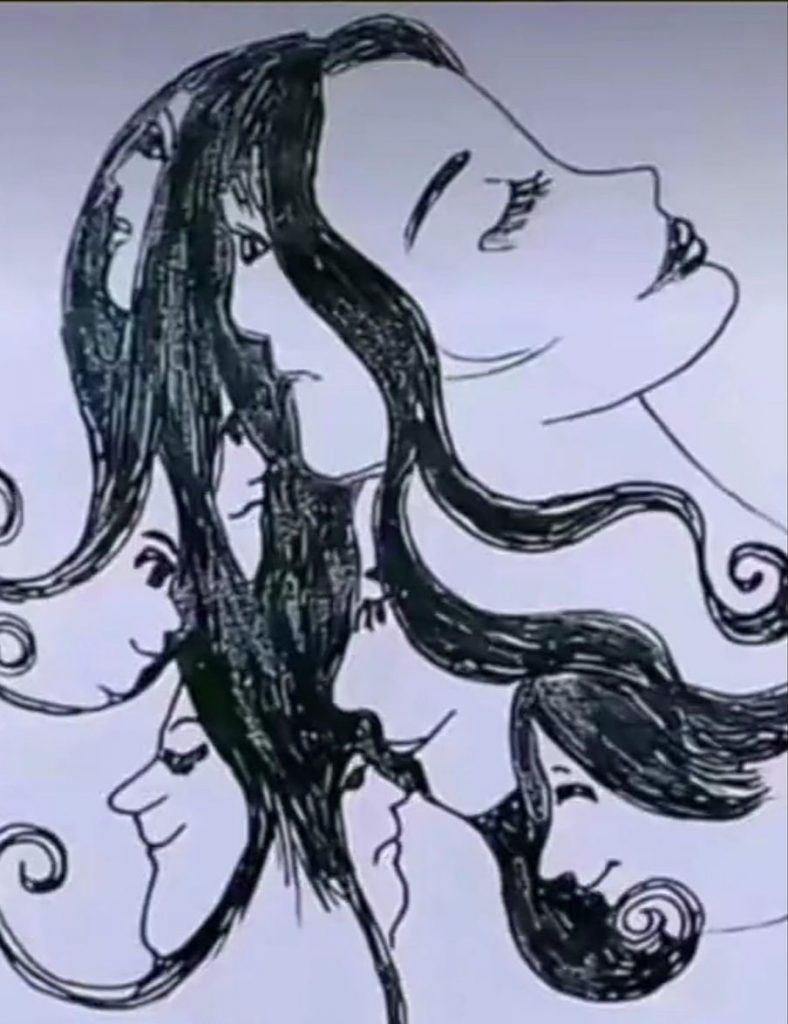
Decoding the Multi-Face Hair Illustration
At first glance, you see a graceful profile of a woman tilting her head back, hair flowing like ink strokes. But look again: within those dark locks lie multiple smaller faces—some in profile, others peeking from negative spaces. The trick: the artist uses the contours of hair strands and gaps between them to form nose-forehead-chin outlines. Each hidden face shares the same flowing line as part of the main figure’s hair, so your brain needs to break free from the primary pattern and reassemble it into new profiles. To decode this illustration, begin by isolating individual “ribbons” of hair. Ask yourself: could this curve be a forehead? Could that slight indentation form a nose? As you scan each section, you may spot faces looking left, right, up, or down. The beauty lies in how seamlessly these profiles integrate: the image feels cohesive until you start noticing dozens of faces woven into one.
Understanding Pareidolia: Why We See Faces Everywhere
Pareidolia isn’t just an art trick; it’s rooted in our evolution. Early humans needed to detect faces quickly—friend or foe? A faint silhouette could signal danger or an ally. Our visual system became finely tuned to pick out face-like patterns, even when none exist. That’s why you might see faces in clouds, tree bark, or toast patterns. Artists harness this instinct, embedding hidden shapes that our brains eagerly latch onto. When you stare at the hair-portrait illusion, your mind oscillates between the obvious woman’s face and the lurking smaller profiles. That oscillation triggers delight: you feel clever for spotting a hidden face and curious to find more. Understanding this psychological underpinning explains why hidden-face puzzles remain so popular—they playfully exploit a deep-seated survival mechanism, turning it into a mental game.

Strategies to Spot Every Hidden Face
Finding all the concealed profiles in a complex illusion demands methodical scanning and fresh perspectives. Here are tactics to maximize your success:
- Divide and Conquer by Zones: Mentally segment the image into sections—top of the head, mid-hair flow, lower strands. Tackle one zone at a time, so no area goes unchecked.
- Focus on Silhouettes: Instead of fixating on details, look at outline shapes. Is a curve in the hair resembling a forehead-to-chin line? Sometimes stepping back and viewing the silhouette as a whole highlights a hidden profile.
- Scan Negative Space: Often, a hidden face appears in the gap between hair strands or between the main figure and background. Train your eyes to catch these empty zones forming facial shapes.
- Change Your Perspective: Tilt your head, view the image upside down, or squint slightly. Altering how you look breaks habitual perception and allows new patterns to emerge.
- Trace with Your Finger or Cursor: Lightly follow a hair strand’s contour with your finger or mouse. This tactile approach guides your gaze along shapes you might otherwise skip.
- Use Contrast Tricks: If you have a printed copy, shading suspected areas lightly with a pencil can confirm if the shape resolves into a face. Digitally, adjusting brightness or inverting colors can unmask subtle outlines.
- Take Breaks: When your eyes tire, step away briefly. Returning with fresh vision often reveals elusive faces you missed before.
- Maintain a Tally: Keep count of faces you’ve identified—either mentally or by lightly marking on a printout. This helps you know when you’ve covered all zones and can gauge how many more to hunt.
By applying these strategies, you’ll transform a daunting sea of hair-like swirls into a treasure hunt of hidden profiles, each discovery fueling your motivation to find the next.
Cognitive Benefits of Hidden-Face Puzzles
Engaging with these illusions isn’t just playful—it offers real mental perks:
- Enhanced Attention to Detail: Actively scanning for subtle shapes trains your brain to notice fine distinctions, improving observational skills useful in everyday tasks, from reading labels to analyzing data.
- Boosted Visual Memory: Remembering which zones you’ve scanned and which faces you’ve found exercises working memory and spatial recall.
- Improved Problem-Solving: Some faces are obvious; others demand creative leaps (“Could that curve form a profile if I view it upside down?”). Switching between analytical and imaginative modes strengthens cognitive flexibility.
- Mindfulness and Stress Relief: Focusing on a single image can quiet distracting thoughts, offering a mini mindfulness session. The sense of achievement from spotting each face releases dopamine, lifting mood.
- Increased Patience and Perseverance: Persisting through elusive differences builds resilience. This “stick-with-it” attitude can carry over to tackling bigger life challenges.
- Social Engagement and Bonding: Sharing discoveries with friends or family sparks conversations, friendly competition, and collaborative problem-solving, boosting emotional well-being.
By highlighting these benefits, you recognize that hidden-face illusions serve as brain workouts, not mere diversions.

Creating Your Own Hidden-Face Illusions
Inspired to craft a similar multi-face artwork? Here’s a step-by-step guide:
- Choose a Base Shape: Decide on a main figure—perhaps a profile, animal form, or abstract shape. This serves as the canvas for embedding additional faces.
- Sketch Primary Contours: Draw the main outline clearly—like a woman’s face with flowing hair. Make sure the shape is distinct and offers plenty of internal curves.
- Identify Potential Face Zones: Look at the flowing elements—hair strands, folds, or abstract lines—and mark slight indentations or bulges where secondary profiles could fit naturally.
- Weave Silhouettes Seamlessly: Adjust the contours so that each hidden profile shares lines with the main shape. For example, a hair strand’s outer edge becomes one face’s forehead, while its inner curl forms another face’s chin.
- Utilize Negative Space: Plan gaps between lines where a face might emerge in reverse—make sure the background around those gaps doesn’t clash.
- Vary Orientations and Sizes: Include faces facing left, right, or even upward. Mix larger, easier-to-spot profiles with smaller, subtler ones for layered challenge.
- Test and Refine: Show drafts to others without hints. Note which faces they spot quickly and which hide too well or too obviously. Tweak line thickness or curvature to balance difficulty.
- Finalize and Present: Create a clean version, perhaps in black-and-white to emphasize contrast. Provide it with a prompt like “How many faces can you find?” Optionally, prepare a reveal image with numbered outlines for each hidden face.
Designing your own illusions deepens appreciation for the artistry and psychology behind pareidolia, and offers engaging content to share online or in educational settings.
Using Hidden-Face Art in Education and Therapy
Hidden-face illusions have versatile applications beyond entertainment:
- Classroom Exercises: Teachers can use them to sharpen students’ observation skills, prompting discussions about perception vs. reality. Art classes might analyze how lines and negative spaces create multiple images.
- Critical Thinking Workshops: Puzzle-solving encourages methodical scanning and flexible thinking, useful in STEM or design education.
- Therapeutic Tools: Counselors sometimes employ ambiguous images to explore clients’ interpretations and emotional responses. Discussing what faces one sees can reveal personal insights or mood.
- Mindfulness Activities: Guided sessions where participants focus on identifying hidden shapes promote present-moment awareness and stress relief.
By integrating these illusions into learning or therapy, you harness their cognitive and emotional benefits in structured, meaningful ways.

Social Sharing and Engagement: Fueling the Puzzle Craze
Hidden-face images thrive on social media and community sharing. Encourage readers to post their face counts, highlight which profiles they found first, or share screen captures of their outlines. Use hashtags like #HiddenFacesChallenge or #PareidoliaArt to connect enthusiasts. Running friendly contests—“First to spot all 10 faces wins a shoutout”—drives engagement. Bloggers and content creators publishing hidden-face puzzles attract traffic from curious solvers and build interactive audiences. Remember to optimize posts with descriptive alt text (“Optical illusion drawing of a woman’s profile with multiple hidden faces in her hair”) for accessibility and SEO.
Deepening Appreciation: Beyond the Puzzle
While the joy of spotting hidden faces is immediate, these illusions also invite reflection on how perception shapes our reality. They remind us that our brains impose patterns onto ambiguity—sometimes leading to creative insights, other times to mistaken assumptions. Recognizing pareidolia’s role encourages both wonder and critical thinking: we learn to enjoy the thrill of discovery while remaining aware that not everything “seen” is objectively there. This balance—between embracing imaginative possibilities and questioning our interpretations—enriches our experience of art and life.

Conclusion: Celebrate Curiosity and Keep Searching for Hidden Faces
The mesmerizing illustration of flowing hair concealing multiple profiles exemplifies the power of optical illusions to engage, entertain, and train our minds. By understanding pareidolia, applying systematic scanning strategies—zone division, silhouette focus, perspective shifts, negative-space awareness—and practicing patience, you can uncover every hidden visage tucked within the design. Beyond the fun “How many faces can you find?” challenge, these puzzles sharpen attention to detail, boost memory, foster creativity, and spark social connection. Whether you’re a puzzle enthusiast, educator, therapist, or artist, hidden-face illusions offer a rich playground for perception and imagination. So next time you spot a swirling pattern or an abstract shape, pause and ask: “What faces might be hiding here?” Embrace your curiosity, celebrate each “Aha!” moment, and keep exploring the fascinating world of hidden images. Happy face hunting!
